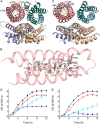Bacterial copper storage proteins
- PMID: 29414794
- PMCID: PMC5880151
- DOI: 10.1074/jbc.TM117.000180
Bacterial copper storage proteins
Abstract
Copper is essential for most organisms as a cofactor for key enzymes involved in fundamental processes such as respiration and photosynthesis. However, copper also has toxic effects in cells, which is why eukaryotes and prokaryotes have evolved mechanisms for safe copper handling. A new family of bacterial proteins uses a Cys-rich four-helix bundle to safely store large quantities of Cu(I). The work leading to the discovery of these proteins, their properties and physiological functions, and how their presence potentially impacts the current views of bacterial copper handling and use are discussed in this review.
Keywords: bacterial copper homeostasis; copper; copper storage; copper transport; metal homeostasis; metalloprotein; methane oxidation; methanotrophs; structural biology.
© 2018 by The American Society for Biochemistry and Molecular Biology, Inc.
Conflict of interest statement
The authors declare that they have no conflicts of interest with the contents of this article
Figures




References
-
- Dennison C. (2005) Investigating the structure and function of cupredoxins. Coord. Chem. Rev. 249, 3025–3054 10.1016/j.ccr.2005.04.021 - DOI
Publication types
MeSH terms
Substances
Associated data
- Actions
- Actions
- Actions
- Actions
- Actions
- Actions
- Actions
- Actions
Grants and funding
LinkOut - more resources
Full Text Sources
Other Literature Sources
Molecular Biology Databases

